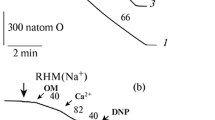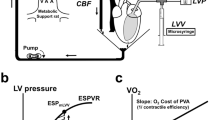Abstract
The contractile function of the isolated rat heart and high energy phosphate content were evaluated under conditions of depressed energy supply caused by disturbances either in mitochondrial ATP production or ATP-phosphocreatine transformation. Amytal (0.3 mM), an inhibitor of mitochondrial respiration, or iodoacetamide (IAA, 0.1 mM) reducing in this dose creatine kinase activity to 19% of the initial level, were used, respectively. Myocardial ATP content remained unaffected in both groups and PCr content decreased to 37% only in amytal-treated group. Very similar alterations in cardiac pump function during volume load were observed in both treated groups; maximal cardiac output was significantly less by 30%, cardiac pressure-volume work by 38–40%, left ventricular (LV) systolic pressure by 24–29%, and LV +dP/dt by 36–39%. In contrast, the extent of decreased LV distensibility was different, a curve relating LV filling volume and end-diastolic pressure was shifted up and to the left much more prominently after IAA treatment. Heart rate was decreased by 24% only in amytal-treated group. Results indicate that a decreased myocardial distensibility is a dominating feature in the acute cardiac pump failure caused by an inhibition of myocardial creatine kinase. Isoproterenol (0.1 μM) substantially increased heart rate and pressure-rate product in IAA-treated hearts but failed to increase cardiac work probably due to its inability to improve myocardial distensibility.
Similar content being viewed by others
References
Bessman SP, Geiger PG: Transport of energy in muscle: the phosphorylcreatine shuttle. Science 211: 448–452, 1981
McClellan G, Weisberg A, Winegrad S: Energy transport from mitochondria to myofibril by a creatine phosphate shuttle in cardiac cells. Amer J Physiol 245: C423-C427, 1983
Veksler VI, Kapelko VI: Creatine kinase in regulation of heart function and metabolism. II. The effect of phosphocreatine on the rigor tension of EGTA-treated rat myocardial fibers. Biochim Biophys Acta 803: 265–270, 1984
Bittl JA, Ingwall JS: The energetics of myocardial stretch. Creatine kinase flux and oxygen consumption in the noncontracting rat heart. Circul Res 58: 378–383, 1986
Shoubridge EA, Jeffry FMH, Keogh JM, Radda GK, Seymour AML: Creatine kinase kinetics, ATP turnover, and cardiac performance in hearts depleted of creatine with the substrate analogue beta-guanidine propionic acid. Biochim Biophys Acta 847: 25–32, 1985
Fossel ET, Hoefeler H: Complete inhibition of creatine kinase in isolated perfused rat hearts. Am J Physiol 252 (Endocrinol Metab 15): E124-E130, 1987
Kupriyanov VV, Lakomkin VL, Kapelko VI, Steinschneider AY, Ruuge EK, Saks VA: Dissociation of adenosine triphosphate levels and contractile function in isovolumic hearts perfused with 2-deoxyglucose. J Mol Cell Cardiol 19: 729–740, 1987
Kapelko VI, Kupriyanov VV, Novikova NA, Lakomkin VL, Steinschneider AY, Severina MY, Veksler VI, Saks VA: The cardiac contractile failure induced by chronic creatine and phosphocreatine deficiency. J Mol Cell Cardiol 20: 465–479, 1988
Kapelko VI, Saks VA, Ruuge EK, Kupriyanov VV, Novikova NA, Lakomkin VL, Steinschneider AY, Veksler VI: The crucial role of creatine kinase for cardiac pump function. In: P.P. De Deyn, B. Marescau, V. Stalon and I.A. Qureshi (eds). Guanidino Compounds in Biology and Medicine, John Libbey and Co. Ltd., London, 1992, pp 249–251
Kupriyanov VV, Lakomkin VL, Korchazhkina OV, Steinschneider AY, Kapelko VI, Saks VA: Control of cardiac energy turnover by cytosolic phosphates: 31P-NMR study. Amer J Physiol 261 (4,Suppl):45–53, 1991
Kapelko VI, Lakomkin VL, Korchazhkina OV: The comparative significance of adenylate and phosphocreatine pathways of energy transport for cardiac pump function. In: P.P. De Deyn, B. Marescau, and I.A. Qureshi (eds). Guanidino Compounds in Biology and Medicine, 1996 (accepted for publication)
Kupriyanov VV, Lakomkin VL, Korchazhkina OV, Stepanov VA, Steinschneider AY, Kapelko VI: Cardiac contractile function, oxygen consumption rate and cytosolic phosphates during inhibition of electron flux by amytal—a31 P-NMR study. Bioch Bioph Acta 1058: 386–399, 1991
Bittl JA, Balschi J, Ingwall JS: Contractile failure and high energy phosphate turnover during hypoxia: 31P-NMR surface coil studies in living rat. Circul Res 60: 871–878, 1987
Kapelko VI, Veksler VI, Novikova NA: Myocardial contracture caused by disturbances in energy production: mechanism and significance. In: A. Katz and V.N. Smirnov (eds). Myocardial metabolism. Harwood Academic Publ., London, 1987, 522–543
Kammermeier H, Schmidt P, Jungling E: Free energy change of ATP hydrolysis: A causal factor of early hypoxic failure of the myocardium. J Mol Cell Cardiol 14: 267–277, 1982
Bittl JA, Balschi J, Ingwall JS: Effects of norepinephrine infusion on myocardial high energy phosphate content and turnover in the living rat. J Clin Invest 79: 1852–1859, 1987
Ventura-Clapier R, Mekhfi H, Vassort G: Role of creatine kinase on force development in chemically skinned rat cardiac muscle. J Gen Physiol 89: 815–837, 1987
Ventura-Clapier R, Saks VA, Vassort G, Lauer C. Elizarova GV: Reversible MM-creatine kinase binding to cardiac myofibrils. Am J Physiol 253 (Cell Physic] 22): C444-C455, 1987
Kupriyanov VV, Korchazhkina OV, Lakomkin VL: Regulation of cardiac energy turnover by coronary flow: A 31P-NMR study. J Mol Cell Cardiol 25: 1235–1247, 1993
Hasenfuss G, Mulieri LA, Leavitt BJ, Alpert NR: Influence of isoproterenol on contractile protein function, excitation-contraction coupling, and energy turnover of isolated nonfailing human myocardium. J Mol Cell Cardiol 26: 1461–1469, 1994
Author information
Authors and Affiliations
Rights and permissions
About this article
Cite this article
Kapelko, V.I., Lakomkin, V.L., Korchazhkina, O.V. et al. Cardiac pump function of the isolated rat heart at two modes of energy deprivation and effect of adrenergic stimulation. Mol Cell Biochem 163, 131–136 (1996). https://doi.org/10.1007/BF00408649
Issue Date:
DOI: https://doi.org/10.1007/BF00408649




